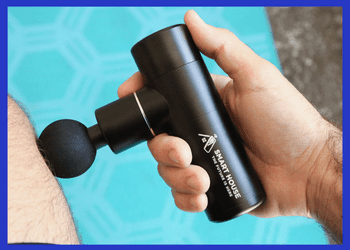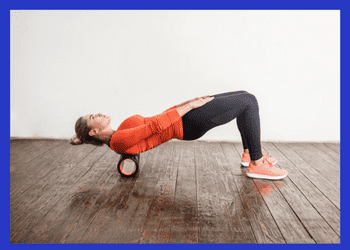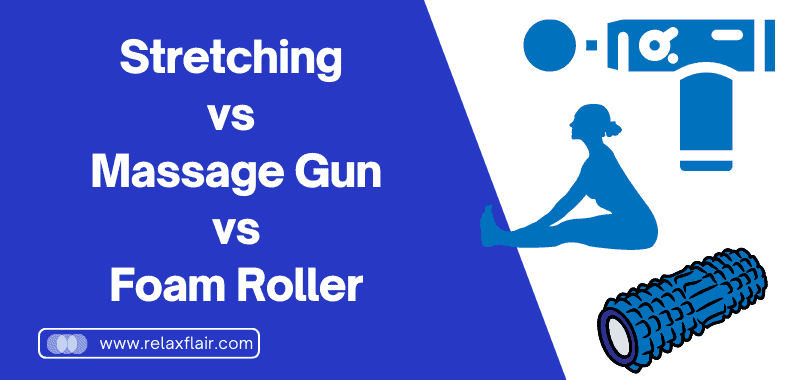For athletes and active individuals, recovery is just as much of a necessity for success as training itself. When the body gets sufficient time to repair and adjust to exercise stress, the outcome will translate into greater performance capabilities and minimal risk of harm. To make sure you’re getting proper rest after strenuous activity, there are various tools available like stretching exercises, massage guns, or foam rollers that may aid in improving your overall health outcomes.
Many massage chairs are equipped with stretching techniques that can help increase flexibility and reduce muscle tension, just like a professional massage therapist. These movements provide an all-encompassing experience to alleviate stress in the body. Massage chairs offer an excellent way to get in a quick, efficient stretch. Their stretching function easily targets specific muscle groups – making it the perfect tool for incorporating stretching into your everyday life.
Understanding the discrepancies between stretching, massage guns, and foam rollers is critical in determining which approach is best suited to your needs. Therefore, we are going to explore how these modalities vary from one another and look at ways they can help athletes recuperate. In this article, you will find out what unique advantages each method holds as well as their respective drawbacks.
Stretching
Stretching is a vital component of any workout routine, as it helps to prevent injuries and speed up recovery. Massage chairs can also provide stretching techniques to enhance this experience. In this article, we will discuss the different types of stretching, the pros and cons of stretching, and real-world examples of athletes who use stretching to their advantage.
Types:
- Static stretching: holding a stretch in one position for an extended period, usually 10-30 seconds
- Dynamic stretching: stretching while in motion, such as walking lunges or arm circles
- PNF stretching: a combination of static and isometric contractions to increase the range of motion
| Pros | Cons |
|---|---|
| Increased range of motion | Potential for injury if not done correctly |
| Improved flexibility | Overstretching can lead to muscle strains |
| Helps prevent injury | Can lead to decreased performance if done before exercise |
| Reduces soreness and stiffness | May not be necessary for everyone |
- Professional football player, Cristiano Ronaldo, incorporates stretching and yoga into his workout routine to prevent injuries and improve flexibility.
- Olympic sprinter, Usain Bolt, includes dynamic stretching in his warm-up routine to prepare his muscles for explosive movements.
Recommendations for Incorporating Stretching in Massage Chairs:
- Start with a warm-up before stretching to avoid injury
- Incorporate a variety of stretching techniques, such as static, dynamic, and PNF
- Be aware of your limits and avoid overstretching
- Use massage chairs to enhance your stretching experience and reach deeper levels of relaxation and recovery
In conclusion, stretching is an important component of any workout routine and can provide numerous benefits for injury prevention and recovery. It is essential to be aware of the different types of stretching and their pros and cons.
Massage chairs can also provide a unique stretching experience, allowing for deeper levels of relaxation and recovery. By incorporating stretching via massage chairs into your regular workout routine, you can improve your overall health and fitness.
Massage Gun
The massage gun, also known as percussion therapy, has gained popularity in recent years as a recovery tool for athletes and active individuals. In this article, we will explore the benefits and drawbacks of using a massage gun as part of a recovery routine.
 Benefits:
Benefits:
- Increased blood flow and circulation to targeted muscles
- Reduced muscle soreness and tension
- Improved range of motion and flexibility
- Enhanced muscle recovery and repair
- Improved lymphatic flow and detoxification
Different Types:
- Percussion: uses a rapid tapping motion to target deep muscle tissue
- Vibration: uses a vibrating motion to loosen and relax muscle fibers
- Kneading: uses a circular motion to help break up muscle knots
- Rolling: uses a rolling motion to promote blood flow and relaxation
| Pros | Cons |
|---|---|
| Increased muscle recovery and repair | Risk of overuse and injury |
| Decreased muscle soreness and tension | Expensive compared to other recovery tools |
| Targeted deep muscle tissue | Can be loud and disruptive |
| Portable and easy to use | Not suitable for all muscle groups |
| Multiple attachments for different areas of the body |
Real-World Examples: Many professional athletes use massage guns as part of their recovery routine, including NBA player LeBron James and NFL player Tom Brady.
Recommendations:
- Consult with a healthcare professional before using a massage gun
- Start with low intensity and gradually increase as needed
- Use the appropriate attachments for targeted muscle groups
- Do not use the massage gun on open wounds or near sensitive areas
- Use in conjunction with other recovery tools, such as stretching and foam rolling, for maximum benefit.
Massage guns have become favored among powerlifters as they reduce muscle soreness and accelerate post-training recovery. Powerlifting is a strenuous activity that necessitates intense workouts, making delayed onset muscle soreness (DOMS) an impediment to peak performance – luckily massage guns alleviate the issue quickly.
Massage guns are an invaluable tool for powerlifters, providing deep tissue massage to specific muscle groups and aiding in the reduction of injury-causing soreness. Utilizing a massage gun before lifting can also warm up muscles and increase the range of motion, making it perfect for pre-workout preparation.
With just a few minutes per session, you’ll be ready to go with improved blood circulation. Powerlifters are often surprised by how much their recovery and performance can improve after integrating massage guns into their workouts. This device is an essential tool for anyone wanting to increase productivity, avoid injuries, and become the best version of themselves in the long term.
Foam Rollers
Did you know that foam rollers are one of the most effective tools for self-myofascial release (SMR) and can help alleviate soreness, stiffness, as well as muscle pain? From athletes to active individuals alike, these cylindrical tubes are becoming increasingly popular components in many recovery regimens.
In this article, we will provide an overview of how foam rollers work and the various types available today. Additionally, readers will learn their advantages & disadvantages – so they may make an informed decision when selecting a roller best suited for them. Ultimately empowering them with the knowledge necessary to incorporate foam rolling into their regular workout routine.
 Foam rollers have several benefits for muscle recovery and pain relief, including:
Foam rollers have several benefits for muscle recovery and pain relief, including:
- Increased flexibility and range of motion
- Improved circulation and blood flow
- Reduced muscle soreness, stiffness, and pain
- Improved balance and coordination
There are several different types of foam rollers available, including:
- Standard: These are the most common type of foam rollers, and come in different densities and lengths.
- Textured: These rollers have a patterned surface to provide a deeper massage and target specific areas.
- Vibrating: These rollers have a built-in motor that provides vibrations to enhance the massage experience.
- Short: These are smaller in size and ideal for targeted muscle release, such as the calves or forearms.
- High-density: These are firmer and provide a deeper massage, but can be more painful for beginners.
Foam rollers have several benefits, but also have some potential drawbacks if not used correctly. The following table summarizes the pros and cons of using foam rollers:
| Pros | Cons |
|---|---|
| Easy to use | Can be painful for beginners |
| Improves flexibility and range of motion | May cause bruising or injury if not used correctly |
| Helps relieve muscle soreness and stiffness | Not effective for all types of muscle pain |
| Affordable and portable | May not provide enough pressure for a deep-tissue massage |
| Can be used for various body parts | May not be suitable for individuals with certain medical conditions |
Many athletes use foam rollers as part of their recovery routine. For example, Olympic sprinter Usain Bolt has been known to use a foam roller to help with his recovery after races. NBA star LeBron James also reportedly uses a foam roller to help keep his body in top shape.
Recommendations for Incorporating Foam Rollers into a Regular Workout Routine
To incorporate foam rollers into a regular workout routine, follow these recommendations:
- Start with a low-density foam roller if you are new to foam rolling, and gradually increase the density as your muscles become accustomed to the pressure.
- Use a textured foam roller or a ball for targeted muscle release, such as the IT band or the glutes.
- Roll slowly and apply enough pressure to feel slight discomfort, but not pain.
- Avoid rolling over bony areas or joints.
- Use foam rollers before and after workouts to help with muscle warm-up and recovery.
Foam rollers are a popular recovery tool among powerlifters and weightlifters due to their ability to target specific muscle groups and provide deep tissue massage. These athletes often use foam rollers as part of their warm-up routine to prepare their muscles for the heavy lifting that follows. Foam rollers can also be used post-workout to aid in muscle recovery and alleviate soreness.
For powerlifters and weightlifters, foam rollers are particularly beneficial for targeting the muscles of the lower back, glutes, hips, and thighs. By using a foam roller regularly, these athletes can improve their range of motion, reduce muscle tension and soreness, and improve their overall performance in the gym.
Comparison and Contrast
| Recovery Tool | Benefits | Drawbacks |
|---|---|---|
| Stretching | Enhance your mobility, improve joint range of motion, decrease muscle stiffness, avert injury and induce a sense of tranquility – all with one simple solution. | Can cause injury if not done correctly, and may not be effective for acute pain |
| Massage Guns | Increases blood flow, reduces muscle soreness, improves range of motion, reduces muscle tension | Can be expensive, may cause bruising or pain if not used correctly, and may not be effective for chronic pain |
| Foam Rollers | Experience an invigorating increase in blood flow and improved overall range of motion. Alleviate muscle tension, reduce soreness, and promote a deep sense of relaxation with this remarkable solution. | Can be painful for beginners, may not be effective for acute pain, and can wear out quickly |
Everyone’s recovery needs are different, so each tool has its own benefits and drawbacks. Stretching is great for improving flexibility but can be risky if not done properly. Massage guns help to relieve muscle tension, though they’re expensive and might cause pain when used incorrectly. Foam rollers are cost-effective yet may not provide adequate relief from acute pain or create discomfort for those who aren’t experienced with it.
When selecting a restoration tool, it is essential to assess your unique needs and exercise plan. Powerlifters and weightlifters could benefit from using a massage gun or foam roller for concentrated muscle groups as well as increased circulation. On the other hand, runners and endurance athletes may gain advantages from stretching which assists in improving the range of motion while thwarting injury. In the end, the most helpful recovery tool for you will vary based on your individual goals and preferences.
To find out which tools are best suited to help support your body post-workout, it might be wise to experiment with a variety of options until you identify what works best for you.
FAQs
What is the Difference Between Static and Dynamic Stretching?
To boost your flexibility and extend your range of motion with static stretching this type of exercise requires holding a stretch for up to 30 seconds, creating long-term results in comparison to dynamic stretching routines. In contrast, dynamic stretching consists of efficiently moving your joints and muscles through their entire range of motion in a cautious way.
It is often modeled after the movements associated with certain athletic activities or exercise routines. Dynamic stretches can enhance flexibility, improve blood circulation, and prepare you for strenuous physical activity; on the other hand static stretching can help to bolster mobility while lessening injury risk.
How Often Should I Use a Massage Gun or Foam Roller?
The frequency of using a massage gun or foam roller depends on various factors, such as the individual’s activity level, training intensity, and recovery needs. Generally, using a foam roller or massage gun for a few minutes before and after exercise can help to improve circulation, reduce muscle soreness, and improve flexibility. Nevertheless, it is vital to pay attention to your body and abstain from overusing these tools because if used excessively or with too much force, they may cause muscle damage or injury.
Can Foam Rolling or Massage Gun Use Cause Injury?
While foam rolling and massage gun use can be beneficial for muscle recovery and relaxation, improper or excessive use can potentially lead to injury. It’s important to follow proper techniques, start with lower-intensity settings, and avoid targeting sensitive or injured areas. If you experience pain or discomfort while using a foam roller or massage gun, stop immediately and consult a healthcare professional.
Final Words
In conclusion, stretching, massage guns, and foam rollers are all effective tools for improving flexibility, reducing muscle soreness, and promoting recovery. Each of these methods has its own unique benefits, and choosing the right one depends on individual needs, preferences, and goals.
Static stretching can be useful for improving flexibility, dynamic stretching can help to prepare the body for exercise, and massage guns and foam rollers can be effective for muscle recovery and relaxation. It’s important to use these tools correctly and to listen to your body to avoid overuse or injury. Ultimately, incorporating a combination of stretching, massage, and self-care techniques can help to optimize athletic performance and promote overall health and wellness.
